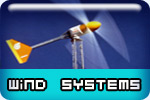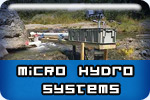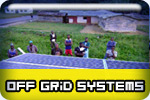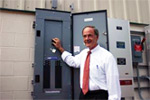Assessment Tools and Resources
Click here for our quick, on-line Evaluation Request form.
If you take a minute to complete our mini-survey and submit our on-line evaluation request form, one of our consultants will contact you to discuss your situation and needs, and to set up a no-obligation site evaluation.
For the ‘Do-It-Yourself’ inclined readers, we thought we’d help you out with a few tools and tips to assist you in exploring your energy needs, and options.
* If you haven’t already read the overview of our small wind and solar systems, you might find it helpful to go to those pages, and read them, before using the assessment tools. *
What is your ‘carbon footprint’? Try out the calculators below to quickly estimate how much carbon dioxide your lifestyle choices and daily power consumption contribute to the environment each year. * Don’t forget to bookmark this site before you go! *
Personal ‘Carbon Footprint’ Calculator
Carbon Emissions Calculator- for Travel & Commuting
If you were amazed to learn how big your ‘carbon footprint’ is, you might want to check out some great energy conservation ideas, brought to you by the U.S. Environmental Protection Agency and the Department of Energy. You can also learn about tax credits for the purchase of qualifying energy efficient home appliances and improvements. If you’re serious about supplying, or supplementing, your own energy needs with a Wise Power System, then it makes sense (and saves dollars!) to reduce your energy consumption, too. These tips don’t necessarily require significant lifestyle change, or sacrifice. Smart conservation in conjunction with Wise Power production, is a winning combination!
Energy Star – Energy Efficiency and Conservation Information
Now that you’ve ‘lightened your carbon load’, so to speak… you can get down to the serious consideration of just how much electricity you use, and how much you want, or need, to produce with your solar and/or wind system. You can review the total kilowatt hours you’ve used in your home or business by reviewing your past monthly utility bills. Of course, those numbers won’t reflect the results of any of your recent energy conservation efforts! You may wish to determine how much electricity only certain systems and appliances use. Here is a chart to help you calculate how much power that items you select use for the number of hours you have them in operation. Then a simple calculation will give you a reasonable estimate of how many kilowatts your system would need to produce to meet your needs.
Link to: How Many Watts Do You Need? Excel worksheet (or table)
Now you know, roughly, how much energy is required to run whichever systems you choose to include in your supply considerations.
Next, you might want to check to see that your state has net-metering (allowing you to tie in to the existing utility grid supply, and sell surplus energy back to the utility company). Most states now allow net metering, but if you live in one of the states that do not, you will need to consider a battery back-up, or scaling your system so you don’t generate a surplus.
Link to: US Map of Net Metering States
So… just how many hours of sunlight, and how much wind does your location get, on average, anyway? Thanks to the long-term cooperative efforts of a whole bunch of dedicated nerdy folks with great technological tools, there are some pretty extensive natural resource maps available on the World Wide Web. You can review the statistical data for your area, before moving on to a more thorough analysis of your specific site.
U.S. Solar Maps – National Renewable Energy Laboratory
National and State Wind Resource Maps – from the Renewable Resource Data Center
If you always liked science classes, then you might enjoy making the observations, measurements, and calculations involved in determining the suitability of your site for a photovoltaic solar power system. At Wise Power Systems we have a handy piece of equipment to make the same determinations for you, much more easily – but if you enjoy ambitious home science projects, then you might find the instructions on this site helpful.
Solar Site Survey – a DIY ‘How To’
Maybe you’d like to explore the performance of some different sized solar panel systems. This site requires a fair amount of informed input to yield meaningful results. You might want to skip this one, and call us to set up a consultation, instead! However, if you’ve already read-up on the ins and outs of photovoltaic solar systems, and you’ve calculated your wattage needs, roof angles, etc., then you might want to check out this calculator.
PV Watts – Performance Calculator for Grid-Connected PV Systems
The Mid-Atlantic region is not the windiest part of the country, but there are locations (micro-climates, such as coastal areas, hills and mountainous regions, for example) where wind power can still be suitable and productive.
State Wind Maps – Wind powering America – U.S. Dept. of Energy
Doing a site analysis to measure your average wind speed is a bit more complex. The best way is to use an anemometer device, mounted in the specific location where you’d like to measure the wind (wind patterns can vary significantly with terrain, obstacles, and altitude), and monitor it’s readings over an extended period of time, and through different seasons.
However, there are some visual clues to significant wind exposure. Look for trees and vegetation around the property that grow significantly away from the prevailing wind (or that are stunted, or dwarfed due to regular intense wind exposure). Observe the behavior of flags, windsocks and other wind-catchers – particularly those in high places – does the wind buoy them up frequently? If you live in a particularly gusty micro-climate, you’re probably already well aware of it. Have you had your share of broken hinges on shutters and storm doors? Lost hats? Broken umbrellas? You get the idea. If you know you live in a windy area, you might want to pursue a mini-wind farm. Our consultants will be happy to discuss the possibilities with you.
Now that you’ve estimated your energy needs, learned smart ways to reduce your energy consumption, and explored the types and sizes of systems that could work for you in your location, what is next? Have a look at the financial incentives available in your area, which can help you afford the investment in a Wise Power System. For more on the dollar issues, see our Economics page.
Database of State Incentives for Renewables and Efficiency













